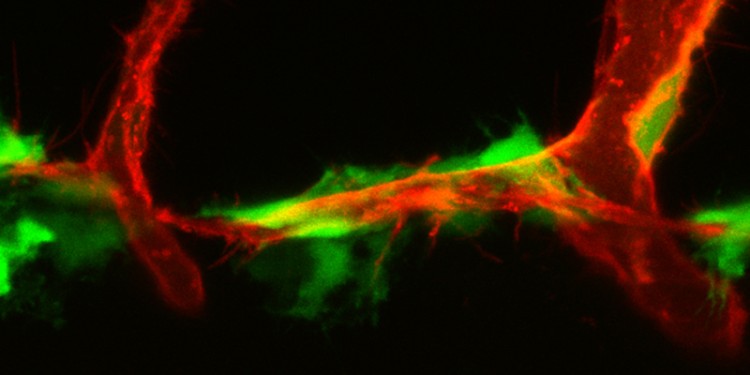
Researchers – knowing exactly what they are doing
It is only 80 to 120 nanometres in size, but its impact is large: the influenza virus. This is the pathogen which as a rule is responsible for the annual flu season – by attacking cells in the body, proliferating inside them, being released from the cell and attacking more cells. This type of proliferation is something which scientists use for cancer research. Prof. Stephan Ludwig from the Institute of Virology is investigating the interaction between viruses and host cells. His group works with so-called oncolytic viruses. These are genetically modified influenza viruses which systematically proliferate in lung cancer cells, for example, destroying them from within. “We provide them with additional ‘tools’ – for example, molecules which have a toxic effect on the tumour cell,” Ludwig explains. “In addition, they pass on so-called cytokines, i.e. messenger substances, which activate the immune response to the cancer cells.” The researchers know exactly what they are doing: they have a detailed knowledge of the virus’ genetic blueprint and can systematically and precisely replace, exchange and augment individual sections of the viral RNA – a process which is just like assembling and dismantling Lego bricks.
In order to prevent the oncolytic viruses from presenting any danger for patients, it has to be ensured that the modified virus cannot proliferate. To this end, the researchers have taken away the gene for the so-called agglutinin protein. This is a surface protein which has to dock onto a host cell before the virus can transfer its RNA into the cell. “Because we have taken something away from the virus, this produces a gap in the virus’ genetic information. We have inserted into this gap the gene for the cytokine interferon-gamma – an important messenger substance in the immune system. It attracts the immune cells to the tumour and, in addition, combats them,” says Stephan Ludwig, explaining the advantages.
From the viruses in the lab … on to the plants. Between Münster’s Schloss and the grounds of the German-Dutch Corps there are several glasshouses which give passers-by a view of the work done by the gardeners here, who cultivate and look after dandelions and tomato, potato and tobacco plants. The numerous plants, both large and small, are waiting to be transferred to the laboratories of the Institute of Biology and the Biotechnology of Plants. Various working groups carry out research here into how plants interact with their environment and what molecular processes take place in the plants. “One of the things we would like to understand is how plants become more resistant to pests or more tolerant of abiotic stress factors such as heat or drought,” says Prof. Antje von Schaewen, the Managing Director of the Institute and head of the Molecular Physiology of Plants working group.
For this purpose, the researchers also work with so-called transgenic plants. These carry in their genetic make-up one or more foreign genes in addition to those genes they have inherited naturally. “By using methods of genetic engineering, we modify plants in order for example to protect them from salt stress or lack of oxygen,” Antje von Schaewen explains. In a recent study she examined transgenic tobacco lines which, under stress, produce more biomass than the non-modified original plants or close relations. A change in the sugar metabolism has the effect of producing more fatty acids, which are transported from the leaves into the inflorescences and seeds. The team is examining the molecular mechanisms which play a role in this.
In the Institute of Cardiovascular Organogenesis and Regeneration, located in the new Multiscale Imaging Centre (MIC) research building on Röntgenstraße, Prof. Stefan Schulte-Merker and his team are researching into the development of blood vessels and lymphatic vessels in the embryos of zebra fish. The group is looking for genes which are responsible for the individual steps in the development of these vessels and whose possible defects lead to diseases in humans – for example lymphedema, which arises as a result of accumulations of fluids in the tissue. The swollen limbs are very painful and susceptible to inflammations. There is no cure – only the symptoms can be treated. “In order to gain a better understanding of this widespread disease and its causes, we use fish in the lab to draw conclusions regarding possible genetic defects in patients,” Stefan Schulte-Merker explains.
In their work, the researchers are helped by the CRISPR/Cas method – a process in genetic engineering for systematically editing and modifying DNA. In this way, genes can be inserted, removed or deactivated. Schulte-Merker and his team use this process to systematically produce mutations in the fishes’ embryos. From the approximately 27,000 genes which a zebra fish possesses, the researchers can pick out any one gene which is relevant to the question they are working on. One big advantage of the process is that the researchers examine the genetic modifications in a systemic context – i.e. in the entire organism of the fish. As the embryos are transparent in the first five days of their life and develop outside the mother fish, the researchers are able to take a look right inside and observe the vessels as they develop. “Under the microscope we can see, live, what changes the mutation involves, how for example it influences the speed at which the lymphatic vessels develop, or their size;” says Stefan Schulte-Merker. “The effects of any genetic defects become clear in a direct comparison with a non-manipulated fish.”
Author: Kathrin Kottke
This article appeared in the University newspaper wissen|leben No. 2, 4 April 2024.
